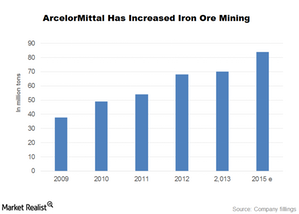Vertically Integrated Steel Mills Are At A Disadvantage
While iron ore prices crashed, production costs for iron ore haven’t come down. Steel plays’ mining operations have been hit by the fall in iron ore prices.
Jan. 9 2015, Updated 1:36 p.m. ET

Vertically integrated steel mills
Earlier in this series, we saw that iron ore prices crashed by ~50% in 2014. However, vertically integrated steel plays—like ArcelorMittal (MT) and U.S. Steel Corp. (X)—haven’t really benefited from the fall. These companies produce most of their iron ore requirements through captive mines.
While iron ore prices crashed, production costs for iron ore haven’t come down. Basically, this means that steel plays’ mining operations have been hit by the fall in iron ore prices. In contrast, companies that source their iron ore requirements from third parties have benefited from lower iron ore prices.
ArcelorMittal’s mining business
The above chart shows how ArcelorMittal grew its mining operations. Since 2009, it almost doubled its iron ore production. It produces almost two-thirds of its iron ore through captive mines.
However, it only produces 20% of its coal through captive mines and long-term contracts. Some of its contracts with coal suppliers are expected to come up for negotiation this year. These contracts should be executed at lower prices—compared to last year. This will benefit ArcelorMittal.
U.S. Steel Corp.
U.S. Steel is largely self-sufficient in the iron ore requirements for its US operations. However, it sources all of its iron ore from third parties in Europe. Our estimates show that it produces ~80% of its iron ore through captive mines.
For coal, U.S. Steel sources all of its requirements from third parties. This should benefit U.S. Steel in 2015.
AK Steel (AKS) could be one of the biggest beneficiaries of lower raw material prices. We’ll analyze this in the next part of this series.
Investors can also access the steel sector through Nucor (NUE). Currently, it’s a top holding of the SPDR S&P Metals and Mining ETF (XME).
